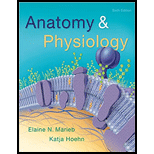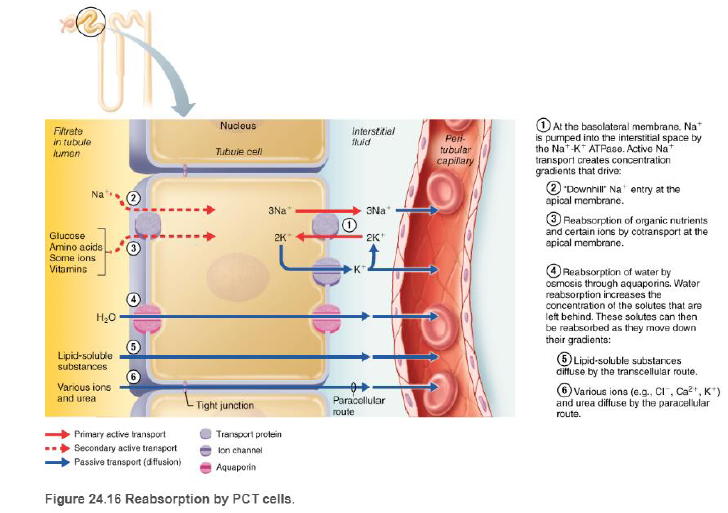
ANATOMY&PHYSIOLOGY W/CD+ATLAS+ACCESSCO
6th Edition
ISBN: 9780134428710
Author: Marieb
Publisher: PEARSON
expand_more
expand_more
format_list_bulleted
Concept explainers
Textbook Question
Chapter 24.5, Problem 18CYU
MAKING conections Primary and secondary active transport processes are shown in Figure 24.16 (and were introduced in Chapter 3) the chapter Cells: The Living Units). How do they differ?

Expert Solution & Answer
Want to see the full answer?
Check out a sample textbook solution
Students have asked these similar questions
The three fundamental classes of proteins involved in transport across membranes are:
i) channelsii) pumpsiii) exchangers
For each class, describe its essential features, explain how transport is accomplished and name at least one representative example.
Explain the difference between simple and facilitated diffusion. This is a hw question
Why is simple diffusion the only possible mechanism of potential movement of molecules across the dialysis membrane in experiment 2?
A migrating fish would be rapidly transferring substances across cell membranes. These substances would include sodium, water, carbon dioxide, oxygen, and steroids. Which of those would be most likely to be moved via active transport? Why?
What is a transmembrane gradient? What is an electrochemical gradient?
Chapter 24 Solutions
ANATOMY&PHYSIOLOGY W/CD+ATLAS+ACCESSCO
Ch. 24.1 - Prob. 1CYUCh. 24.1 - From inside to outside, list the three layers of...Ch. 24.1 - The lumen of the ureter is continuous with a space...Ch. 24.2 - Name the tubular components of a nephron in the...Ch. 24.2 - What are the structural differences between...Ch. 24.2 - What type of capillaries are the glomerular...Ch. 24.2 - Prob. 19CYUCh. 24.3 - In the kidneys, tubular secretion of a substance...Ch. 24.4 - Extrinsic and intrinsic controls of GFR serve two...Ch. 24.4 - Calculate net filtration pressure given the...
Ch. 24.4 - Which of the pressures that determine NFP is...Ch. 24.5 - In which part of the nephron does most...Ch. 24.5 - How does the movement of Na+ drive the...Ch. 24.5 - MAKING conections Primary and secondary active...Ch. 24.6 - List several substances that are secreted into the...Ch. 24.7 - Describe the special characteristics of the...Ch. 24.7 - Under what conditions is ADH released from the...Ch. 24.8 - What would you expect the normal clearance value...Ch. 24.8 - What are the three major nitrogenous wastes...Ch. 24.9 - A kidney stone blocking a ureter would interfere...Ch. 24.9 - What is the trigone of the bladder, and which...Ch. 24.9 - Name the three regions of the male urethra.Ch. 24.9 - How does the detrusor respond to increased firing...Ch. 24.9 - MAKING connections Compare the structure and...Ch. 24 - The lowest blood concentration of nitrogenous...Ch. 24 - The glomerular capillaries differ from other...Ch. 24 - Damage to the renal medulla would interfere first...Ch. 24 - Which is reabsorbed by the proximal convoluted...Ch. 24 - Glucose is not normally found in the urine because...Ch. 24 - Filtration at the glomerulus is inversely related...Ch. 24 - Tubular reabsorption (a) of glucose and many other...Ch. 24 - If a freshly voided urine sample contains...Ch. 24 - Conditions such as diabetes mellitus and...Ch. 24 - Which of the following is/are true about ADH? (a)...Ch. 24 - What is the importance of the perirenal fat...Ch. 24 - Trace the pathway a creatinine molecule takes from...Ch. 24 - Explain the important differences between blood...Ch. 24 - Describe the mechanisms that contribute to renal...Ch. 24 - Prob. 5SAQCh. 24 - Describe what is involved in active and passive...Ch. 24 - Explain how the peritubular capillaries are...Ch. 24 - Explain the process and purpose of tubular...Ch. 24 - How does aldosterone modify the chemical...Ch. 24 - Explain why the filtrate becomes hypotonic as it...Ch. 24 - How does urinary bladder anatomy support its...Ch. 24 - Define micturition and describe the micturition...Ch. 24 - Lets return to Kyle Boulard, whom we met in the...Ch. 24 - Lets return to Kyle Boulard, whom we met in the...Ch. 24 - Lets return to Kyle Boulard, whom we met in the...Ch. 24 - Lets return to Kyle Boulard, whom we met in the...Ch. 24 - Lets return to Kyle Boulard, whom we met in the...Ch. 24 - Lets return to Kyle Boulard, whom we met in the...Ch. 24 - Lets return to Kyle Boulard, whom we met in the...
Knowledge Booster
Learn more about
Need a deep-dive on the concept behind this application? Look no further. Learn more about this topic, biology and related others by exploring similar questions and additional content below.Similar questions
- Without saturation of transport proteins and under the same concentration gradient how can the speed of simple diffusion be compared to the speed of facilitated diffusion?arrow_forwardMolecules cannot move naturally through tje selmembrane against its diffusion gradient,but it does.Explain this statement critically using the sodium-potassium pump diagramarrow_forwardWhich is not required for passive transport across a membrane (select all that apply and explain why): a concentration gradient a cotransported ion energy a protein channelarrow_forward
- What are the 3 types of active transport? Be able to diagram each process. What is required for each of these processes? How are they similar, how are they different?arrow_forwardUsually , rates of diffusion vary inversely with molecular weights; so smaller molecules diffuse faster than do larger ones. In cells, however, calcium ion diffuses more slowly than does cAMP. Propose a possible explanation.arrow_forward"Transporters saturate at high concentrations of the transported molecule when all their binding sites are occupied; channels, on the other hand, do not bind the ions they transport and thus the flux of ions through a channel does not saturate." is true or false.arrow_forward
- A migraine fish would be rapidly transferring substances across cell membrane. The substances would include sodium, water, carbon dioxide, oxygen, and steroids. Which of those would most likely be moved via active transport? Why?arrow_forward"Transport by transporters can be either active or passive, whereas transport by channels is always passive" is true or false.arrow_forwardPassive transport across the membrane mediated by a carrier— would not be saturated by increasing amount of substance to be transported. does not require energy (ATP). can be driven in reverse. moves the solute through the membrane in the “uphill” direction of their concentration gradient. is faster than transport mediated by channel proteins.arrow_forward
- Describe primary and secondary active transport across a membrane, includingdetails of the major differences between these mechanisms.arrow_forwardsummarizes several of the many types of transporters in the cells of the human body. List a few ways in which the variety of transport mechanisms shown here relate to the general principle of physiology that homeostasis is essential for health and survival.arrow_forwardWhat Osmotic conditions would be favored by Plant and Animal cells? Why? Explain what is meant by the Fluid Mosaic Model of Membrane Structure. What are the various functions of membrane proteins? Explain the different forms of membrane transport: Passive, Facilitated, Active. Describe the bulk transport mechanisms of Endocytosis and Exocytosis.arrow_forward
arrow_back_ios
SEE MORE QUESTIONS
arrow_forward_ios
Recommended textbooks for you
 Human Anatomy & Physiology (11th Edition)BiologyISBN:9780134580999Author:Elaine N. Marieb, Katja N. HoehnPublisher:PEARSON
Human Anatomy & Physiology (11th Edition)BiologyISBN:9780134580999Author:Elaine N. Marieb, Katja N. HoehnPublisher:PEARSON Biology 2eBiologyISBN:9781947172517Author:Matthew Douglas, Jung Choi, Mary Ann ClarkPublisher:OpenStax
Biology 2eBiologyISBN:9781947172517Author:Matthew Douglas, Jung Choi, Mary Ann ClarkPublisher:OpenStax Anatomy & PhysiologyBiologyISBN:9781259398629Author:McKinley, Michael P., O'loughlin, Valerie Dean, Bidle, Theresa StouterPublisher:Mcgraw Hill Education,
Anatomy & PhysiologyBiologyISBN:9781259398629Author:McKinley, Michael P., O'loughlin, Valerie Dean, Bidle, Theresa StouterPublisher:Mcgraw Hill Education, Molecular Biology of the Cell (Sixth Edition)BiologyISBN:9780815344322Author:Bruce Alberts, Alexander D. Johnson, Julian Lewis, David Morgan, Martin Raff, Keith Roberts, Peter WalterPublisher:W. W. Norton & Company
Molecular Biology of the Cell (Sixth Edition)BiologyISBN:9780815344322Author:Bruce Alberts, Alexander D. Johnson, Julian Lewis, David Morgan, Martin Raff, Keith Roberts, Peter WalterPublisher:W. W. Norton & Company Laboratory Manual For Human Anatomy & PhysiologyBiologyISBN:9781260159363Author:Martin, Terry R., Prentice-craver, CynthiaPublisher:McGraw-Hill Publishing Co.
Laboratory Manual For Human Anatomy & PhysiologyBiologyISBN:9781260159363Author:Martin, Terry R., Prentice-craver, CynthiaPublisher:McGraw-Hill Publishing Co. Inquiry Into Life (16th Edition)BiologyISBN:9781260231700Author:Sylvia S. Mader, Michael WindelspechtPublisher:McGraw Hill Education
Inquiry Into Life (16th Edition)BiologyISBN:9781260231700Author:Sylvia S. Mader, Michael WindelspechtPublisher:McGraw Hill Education

Human Anatomy & Physiology (11th Edition)
Biology
ISBN:9780134580999
Author:Elaine N. Marieb, Katja N. Hoehn
Publisher:PEARSON

Biology 2e
Biology
ISBN:9781947172517
Author:Matthew Douglas, Jung Choi, Mary Ann Clark
Publisher:OpenStax

Anatomy & Physiology
Biology
ISBN:9781259398629
Author:McKinley, Michael P., O'loughlin, Valerie Dean, Bidle, Theresa Stouter
Publisher:Mcgraw Hill Education,

Molecular Biology of the Cell (Sixth Edition)
Biology
ISBN:9780815344322
Author:Bruce Alberts, Alexander D. Johnson, Julian Lewis, David Morgan, Martin Raff, Keith Roberts, Peter Walter
Publisher:W. W. Norton & Company

Laboratory Manual For Human Anatomy & Physiology
Biology
ISBN:9781260159363
Author:Martin, Terry R., Prentice-craver, Cynthia
Publisher:McGraw-Hill Publishing Co.

Inquiry Into Life (16th Edition)
Biology
ISBN:9781260231700
Author:Sylvia S. Mader, Michael Windelspecht
Publisher:McGraw Hill Education
The Cell Membrane; Author: The Organic Chemistry Tutor;https://www.youtube.com/watch?v=AsffT7XIXbA;License: Standard youtube license